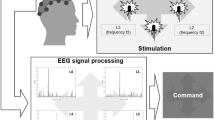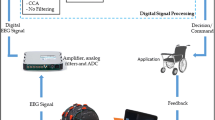Abstract
Brain-Computer Interface (BCI) is a communication method based on brain signals analysis. The interface enables controlling applications such as a wheelchair with minimal muscle effort, making BCI systems attractive in assistive technology development. Currently, Steady-State Visually Evoked Potential (SSVEP) represents one of the most promising BCI paradigms, since a specific physiological brain response is evoked when a subject is exposed to continuously flickering visual stimuli. In this study, we evaluated how the parameters of the Minimum Variance Distortionless Response (MVDR) filter impact the performance of the SSVEP-based BCI. Three parameters were analyzed: filter order, number of EEG signals combined at the filter input, and number of electrodes employed for filtering. Our results show that it is convenient to employ fewer electrodes, as they are closer to the visual cortex region, and to combine them spatially, using low filter orders. The best performance, among the tested configurations, was 80.20 ± 6.65%, obtained with filter order nine, employing nine EEG signals and spatially combining the inputs with eight signals at a time.
Supported by FAPEMIG and UFOP.
Access this chapter
Tax calculation will be finalised at checkout
Purchases are for personal use only
Similar content being viewed by others
References
Carvalho, S.N., et al.: Space-time filter for SSVEP brain-computer interface based on the minimum variance distortionless response. Med. Biol. Eng. Comput. 59(5), 1133–1150 (2021). https://doi.org/10.1007/s11517-021-02345-7
Graimann, B., Allison, B., Pfurtscheller, G.: Brain-computer interfaces: a gentle introduction. In: Graimann, B., Pfurtscheller, G., Allison, B. (eds.) Brain-Computer Interfaces. The Frontiers Collection, pp. 1–27. Springer, Heidelberg (2009). https://doi.org/10.1007/978-3-642-02091-9_1
Guger, C., et al.: How many people could use an SSVEP BCI? Front. Neurosci. 6, 169 (2012)
Haykin, S.: Neural Networks and Learning Machines, 3 edn. Pearson Education India (2010)
Benesty, J., Chen, J., Huang, Y.: A generalized MVDR spectrum. IEEE Trans. Audio Electroacoust. 12(8673104), 827–830 (2005)
Liu, B., Chen, X., Shi, N., Wang, Y., Gao, S., Gao, X.: Improving the performance of individually calibrated SSEVP-BCI by task-discriminant component analysis. IEEE Trans. Neural Syst. Rehabil. Eng. 29, 1998–2007 (2021)
Liu, Z., Shore, J., Wang, M., Yuan, F., Buss, A., Zhao, X.: A systematic review on hybrid EEG/fNIRS in brain-computer interface. Biomed. Signal Process. Control 68, 102595 (2021)
Neumann, W.J., et al.: The sensitivity of ECG contamination to surgical implantation site in brain computer interfaces. Brain Stimul. 14(5), 1301–1306 (2021)
Oikonomou, V.P., Nikolopoulos, S., Kompatsiaris, I.: A Bayesian multiple kernel learning algorithm for SSVEP BCI detection. IEEE J. Biomed. Health Inform. 23(5), 1990–2001 (2018)
Oppenheim, A.V.: Discrete-Time Signal Processing. Pearson Education India (1999)
Sözer, A.T., Fidan, C.B.: Novel spatial filter for SSVEP-based BCI: a generated reference filter approach. Comput. Biol. Med. 96, 98–105 (2018)
Theodoridis, S., Koutroumbas, K.: Pattern Recognition, 3rd edn. Academic Press, San Diego (2006)
Vargas, G.V., Carvalho, S.N., Boccato, L.: Analysis of the spatiotemporal MVDR filter applied to BCI-SSVEP and a filter bank extension. Biomed. Signal Process. Control 73, 103459 (2022)
Vargas, G.V.: Filtragem espaço-temporal baseada no princípio MVDR aplicada a interfaces cérebro-computador sob o paradigma SSVEP. Master’s thesis, Universidade Estadual de Campinas (2021)
Vialatte, F.B., Maurice, M., Dauwels, J., Cichocki, A.: Steady-state visually evoked potentials: focus on essential paradigms and future perspectives. Prog. Neurobiol. 90(4), 418–438 (2010)
Wang, Y., Chen, X., Gao, X., Gao, S.: A benchmark dataset for SSVEP-based brain-computer interfaces. IEEE Trans. Neural Syst. Rehabil. Eng. 25(10), 1746–1752 (2016)
Wolpaw, J., Birbaumer, N., McFarland, D., Pfurtscheller, G., Vaughan, T.: Brain-computer interfaces for communication and control. Clin. Neurophysiol. 113(6), 767–791 (2002)
Author information
Authors and Affiliations
Corresponding author
Editor information
Editors and Affiliations
Ethics declarations
Conflict of Interest
The authors declare that they have no conflict of interest.
Rights and permissions
Copyright information
© 2022 The Author(s), under exclusive license to Springer Nature Switzerland AG
About this paper
Cite this paper
Lima, L.B., Viana, R.F., Rosa-Jr., J.M., Leite, H.M.A., Vargas, G.V., Carvalho, S.N. (2022). Analysis of the Influence of the MVDR Filter Parameters on the Performance of SSVEP-Based BCI. In: Xavier-Junior, J.C., Rios, R.A. (eds) Intelligent Systems. BRACIS 2022. Lecture Notes in Computer Science(), vol 13653. Springer, Cham. https://doi.org/10.1007/978-3-031-21686-2_22
Download citation
DOI: https://doi.org/10.1007/978-3-031-21686-2_22
Published:
Publisher Name: Springer, Cham
Print ISBN: 978-3-031-21685-5
Online ISBN: 978-3-031-21686-2
eBook Packages: Computer ScienceComputer Science (R0)




